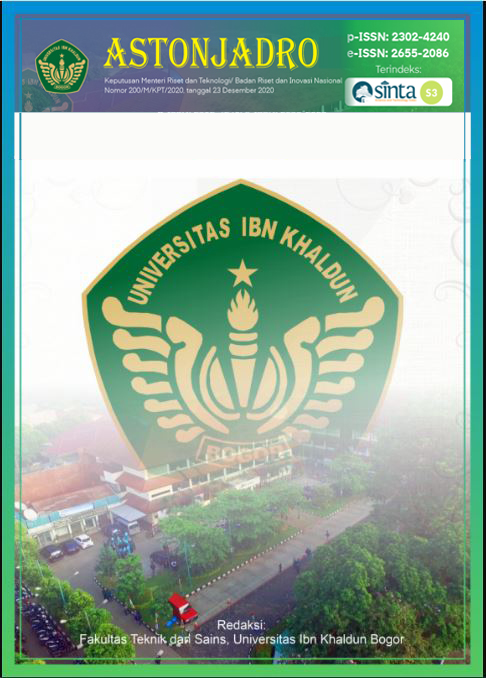Impact of Land Use and Transport Interaction on Transmition of COVID-19 in Jakarta
DOI:
https://doi.org/10.32832/astonjadro.v11i3.7169Keywords:
land use, bus stop, COVID-19, disaster, intensity.Abstract
Land use and transportation are well known to interact and influence one another. The COVID-19 pandemic is the global health crisis. The world faces difficulties managing disasters while making efforts to slowing the spread of COVID-19. The COVID-19 pandemic spreads quickly through physical contact, making it easy to spread in public places. The purpose of this study to determine the effects of land use and transportation interactions on COVID-19 transmission. The quantitative descriptive analysis and spatial statistical methods in Geographic Information Systems (GIS) have been used in this study. Descriptive analysis to describe data related to land use characteristics in the research area. Spatial Statistical Method in GIS to analyze data from both structured and spatial observations. Cross-checking the land use from Google Street View around the bus stop within a 400 meter radius with the existing land use directly yielded the observations. The findings revealed that the type of land use demonstrated an intensity of activity that had a high potential for spreading COVID-19 because at the bus stop with land use around the trading center, shopping centers, and office buildings that have a high activity intensity, it appears that they have a high positive number of COVID-19References
Atika Nur, F. 2013. Kantor Sewa di Mega Kuningan Dengan Pendekatan Arsitektur Hemat energi (Issue Doctoral dissertation Universitas Gadjah Mada).
Browne, A., Ahmad, S. S. t. O., Beck, C. R., & Nguyen-Van-Tam, J. S. 2016. The roles of transportation and transportation hubs in the propagation of influenza and coronaviruses: a systematic review. Journal of Travel Medicine, 23(1), 1–7. https://doi.org/10.1093/jtm/tav002
Castelli, F., & Sulis, G. 2017. Migration and infectious diseases. Clinical Microbiology and Infection, 23(5), 283–289. https://doi.org/10.1016/j.cmi.2017.03.012
Christiana, N. E. 2017. Pengembangan Jalur Pejalan Kaki dengan Konsep Walkable City Koridor Dukuh Atas Jakarta Berdasarkan Preferensi Pengguna. Doctoral Dissertation, Institut Teknologi Sepuluh Nopember.
Errampalli, M., Patil, K. S., & Prasad, C. S. R. K. 2020. Case Studies on Transport Policy Evaluation of integration between public transportation modes by developing sustainability index for Indian cities. Case Studies on Transport Policy, 8(1), 180–187. https://doi.org/10.1016/j.cstp.2018.09.005.
Guzman, L. A., Oviedo, D., & Rivera, C. 2017. Assessing equity in transport accessibility to work and study: The Bogotá region. Journal of Transport Geography, 58, 236–246. https://doi.org/10.1016/j.jtrangeo.2016.12.016
Hackl, J., & Dubernet, T. 2019. Epidemic spreading in urban areas using agent-based transportation models. Future internet, 11(4), 92.
Hanson, Susan; Genevieve, G. 2017. The Geography of Urban Transportation (Fourth). Guilford Publications.
ICSC. 2019. Shopping Center Definitions. International Council of Shopping Centers. https://doi.org/https://www.icsc.com/news-and-views/research/shopping-centerdefinitions
Indraprahasta, G. S., & Derudder, B. 2019. World City-ness in a historical perspective: Probing the long-term evolution of the Jakarta metropolitan area. Habitat International, 89(May 2018), 102000.
https://doi.org/10.1016/j.habitatint.2019.102000.
Levy, M., & Weitz, B. A. 2009. Retailing Management. McGraw Hill.
Li, J., Xiang, T., & He, L. 2021. Modeling epidemic spread in transportation networks: A review. Journal of Traffic and Transportation Engineering (English Edition).
Michael, W. 2003. A Land Use – Transportation Perspective of Urban Processes.
Miro, F. 2005. Perencanaan Transportasi untuk Mahasiswa, Perencana dan Praktisi. Erlangga.
Saragi, T. E. 2015. Pengaruh Sistem Penanganan Transportasi Yang Berkelanjutan Terhadap Lingkungan di Perkotaan (Studi Literatur). Universitas HKBP Nommensen.
Tamin, O. Z. 2000. Perencanaan dan Pemodelan Transportasi. In Perencanaan dan pemodelan transportasi.
Tan, L., & Ma, C. 2021. Choice behavior of commuters' rail transit mode during the COVID-19 pandemic based on logistic model. Journal of Traffic and Transportation Engineering (English Edition), 8(2), 186-195.
Tatem, A. J., Rogers, D. J., & Hay, S. I. 2006. Global Transport Networks and Infectious Disease Spread. Advances in Parasitology, 62(April), 293–343. https://doi.org/10.1016/S0065-308X(05)62009-X.
Tirachini, A., & Cats, O. 2020. COVID-19 and public transportation: Current assessment, prospects, and research needs. Journal of Public Transportation, 22(1), 1–34. https://doi.org/10.5038/2375-0901.22.1.1.
Troko, J., Myles, P., Gibson, J., Hashim, A., Enstone, J., Kingdon, S., Packham, C., Amin, S., Hayward, A., & Van-Tam, J. N. 2011. Is public transport a risk factor for acute respiratory infection? BMC Infectious Diseases, 11, 2–7. https://doi.org/10.1186/1471-2334-11-16.
Xiong, C., Hu, S., Yang, M., Younes, H. N., Luo, W., Ghader, S., & Zhang, L. 2020. Data-driven modeling reveals the impact of stay-at-home orders on human mobility during the COVID-19 pandemic in the US. arXiv preprint arXiv:2005.00667.
Zhang, Junyi. 2020. Transport policymaking that accounts for COVID-19 and future public health threats: A PASS approach. Transport policy 99 : 405-418.
Zhang, Y., Zhang, A., & Wang, J. 2020. Exploring the roles of high-speed train, air and coach services in the spread of COVID-19 in China. Transport Policy, 94(May), 34– 42. https://doi.org/10.1016/j.tranpol.2020.05.012.
Zheng, R., Xu, Y., Wang, W., Ning, G., & Bi, Y. 2020. Spasial l transmission of COVID-19 via public and private transportation in China. Travel Medicine and Infectious Disease, 34(February). https://doi.org/10.1016/j.tmaid.2020.101626.
Zolnik, E. J., Malik, A., & Irvin-Erickson, Y. 2018. Who benefits from bus rapid transit? Evidence from the Metro Bus System (MBS) in Lahore. Journal of Transport Geography, 71(July), 139–149. https://doi.org/10.1016/j.jtrangeo.2018.06.019.
Downloads
Published
How to Cite
Issue
Section
License
Copyright (c) 2022 ASTONJADRO: CEAESJ

This work is licensed under a Creative Commons Attribution-ShareAlike 4.0 International License.
Paper submitted to ASTONJADRO is the sole property of the Astonjadro Journal. Unless the author withdraws the paper because he does not want to be published in this journal. The publication rights are in the journal Astonjadro.ASTONJADRO
LICENSE
This work is licensed under a Creative Commons Attribution-ShareAlike 4.0 International License.
Based on a work at http://ejournal.uika-bogor.ac.id/index.php/ASTONJADRO













